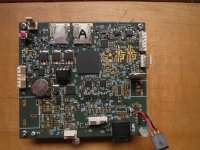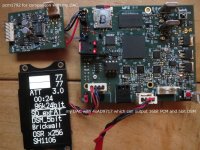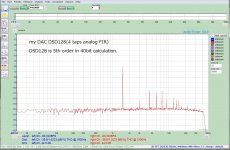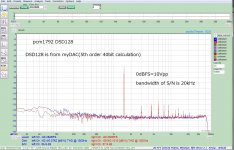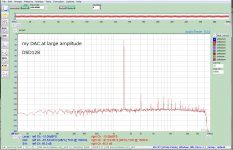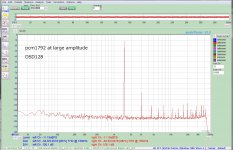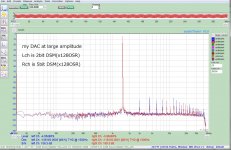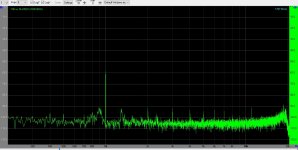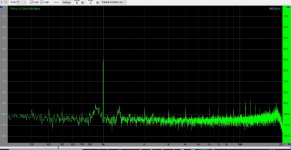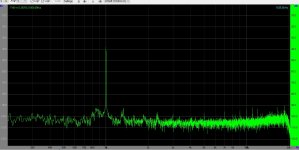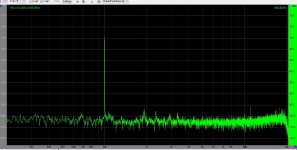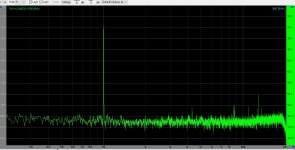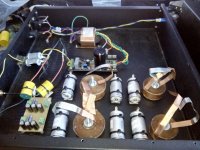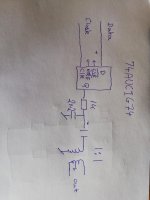Thank you, what software/programm do you use to rip vinyl?
If you mean my hardware (ADC) to digitalize vinyl, It's DIYed ADC board which has SDcard(fat32) on the PCB to memorize wav file. The input of my ADC is external RIAA equalizer which has differential 5Vpp output. Digital data is stored in SDcard, where hardware control including rec and stop is done by a microcontroller(LTC1347) on the board. So, no software like Windows controlled USB devices exist. Just push rec button and stop, then you finish ripping.
Attachments
@xx3stksm:
Thanks for the info. One more question, though, which puzzles me a bit and that I hope you may help clarify:
... to my knowledge the PCM1792 doesn't play back DSD (?) ... Do you mean the DSD1792? And, if yes, can I ask you if you have compared it with an ES9038 based DAC (that is well-executed)?
Cheers,
Jesper
Yes, DSM is Delta Sigma Modulation with 1bit,2bit, and up to 6bit resolution. DSD I mean is 1bit DSM(2 values, 0 and 1) used for no DAC project. 2bit DSM means 3 values, 01(positive),00(zero), and 10(negative).
Thanks for the info. One more question, though, which puzzles me a bit and that I hope you may help clarify:
I measured pcm1792 in DSD mode, but haven't measured in PCM. It needs some modification on my DIY PCB. The only data I have is done with a CD player, which is far inferior to DSD mode of my DIY PCB.
... to my knowledge the PCM1792 doesn't play back DSD (?) ... Do you mean the DSD1792? And, if yes, can I ask you if you have compared it with an ES9038 based DAC (that is well-executed)?
Cheers,
Jesper
Pcm1792 can playback DSD if you have software converter(Rpi) or a hardware one from PCM to DSD. My solution is to use my DAC output because it has internal PCM to DSD converter(1bit DSM) in FPGA. A small PCB at the upper left(attached pic) is my DIYed pcm1792 board for comparison. I have now finished modification to my DIYed pcm1792 board to make it capable in PCM mode. The result was a little bit surprising. My DIYed pcm1792 in PCM mode has almost the same numbers as those in DSD mode(DSM conversion is done by my AD9717DAC as in pic).
CD-S2000(pioneer), which uses two pcm1794s(hardware configuration version of pcm1792) in PCM mode, is far inferior to my DIYed one if the input is bandlimited real music file at post #2004. Standard 1kHz sine can't uncover the difference. I'm not sure how much the difference in real music measurement affects SQ. But CD-S2000 has way worse THD+N in the real situation though both have the same DAC chip.
I guess this comes from poor physical implementation. CD-S2000 isn't multi-layer PCB while mine is 4-layer. My experience tells mixed signal circuit must have a solid ground plane. But I haven't found an objective result in the audio application why multi-layer is mandatory(nobody uses two-layer in video application). This can be one evidence. Another measurement data by real music has interesting results. I will open a new thread about this when I have finished a relative comparison.
CD-S2000(pioneer), which uses two pcm1794s(hardware configuration version of pcm1792) in PCM mode, is far inferior to my DIYed one if the input is bandlimited real music file at post #2004. Standard 1kHz sine can't uncover the difference. I'm not sure how much the difference in real music measurement affects SQ. But CD-S2000 has way worse THD+N in the real situation though both have the same DAC chip.
I guess this comes from poor physical implementation. CD-S2000 isn't multi-layer PCB while mine is 4-layer. My experience tells mixed signal circuit must have a solid ground plane. But I haven't found an objective result in the audio application why multi-layer is mandatory(nobody uses two-layer in video application). This can be one evidence. Another measurement data by real music has interesting results. I will open a new thread about this when I have finished a relative comparison.
Attachments
For all of you wondering where the audible distortions with many no-dacs, when playing at low volumes, extremely dynamic music, or when fade in or fade outs are at play (especially at high dsd rates):
Just a quick look at how a single ended Potato Semi flip flop behaves with different algorithms by HQPlayer, having a simple 2nd order analog output filter.
The test signal is 1KHz, -60dB @ DSD512.
The first image is taken with the DSD7 +256FS modulator,
the second with the AMSDM7 512+FS type, both Poly-sinc-2s.
Is it possible to mimic this in Jriver?
Maybe use HQPlayer after Jriver?
Did you listen to the AMSDM7 512+FS algorithms and how does it soun compared to direct DSD?
Last edited:
Is it possible to mimic this in Jriver?
Maybe use HQPlayer after Jriver?
Did you listen to the AMSDM7 512+FS algorithms and how does it soun compared to direct DSD?
As far as I know, the AMSDM7 512+FS, or something similar, is exclusively developed by Jussi of HQPlayer, for HQPlayer. I don't think anyone else has it.
I thought the foobar pcm-to-dsd is the same as the software used in JRiver, I haven't tested it but assume they're just slightly different order of modulators, nothing else, the amsdm7 is a different beast alltogether, hence the result is different.
I have listened to it. It sounds a lot "cleaner", so to speak. Same resolution upgrade as normal with the higher dsd rates, but without the artifacts at those high speeds, for instance: music doesn't fade away in a modulating, noisy background or with squishy or higher pitched tones.
You might not have noticed before, but with music that has high dynamic range and at a realistic level played, you're bound to notice it. With headphones it's even easier. If not: you're in luck
You can try the software for free for a month if I'm not mistaken. It's cross platform suited but not cheap and afaik doesn't take JRiver as a frontend. Roon is great though (best option imho) and there are other front ends available. It's just the only software that matches excellent with these kind of dacs, because it let's you have controll over the important software part that your no-dac hardware needs.
Anyway, you should try is all I can say.
Edit: with direct dsd you mean the standard dsd64/sacd/dsf format? The artefacts can be measured, I guess, at those low rates, but I have never heard them at these rates so never bothered measuring it. I usually convert pcm to dsd512 and at those rates it's normal to have those issues. You need a powerfull pc though.
Last edited:
As far as I know, the AMSDM7 512+FS, or something similar, is exclusively developed by Jussi of HQPlayer, for HQPlayer. I don't think anyone else has it.
I thought the foobar pcm-to-dsd is the same as the software used in JRiver, I haven't tested it but assume they're just slightly different order of modulators, nothing else, the amsdm7 is a different beast alltogether, hence the result is different.
I have listened to it. It sounds a lot "cleaner", so to speak. Same resolution upgrade as normal with the higher dsd rates, but without the artifacts at those high speeds, for instance: music doesn't fade away in a modulating, noisy background or with squishy or higher pitched tones.
You might not have noticed before, but with music that has high dynamic range and at a realistic level played, you're bound to notice it. With headphones it's even easier. If not: you're in luck
You can try the software for free for a month if I'm not mistaken. It's cross platform suited but not cheap and afaik doesn't take JRiver as a frontend. Roon is great though (best option imho) and there are other front ends available. It's just the only software that matches excellent with these kind of dacs, because it let's you have controll over the important software part that your no-dac hardware needs.
Anyway, you should try is all I can say.
Edit: with direct dsd you mean the standard dsd64/sacd/dsf format? The artefacts can be measured, I guess, at those low rates, but I have never heard them at these rates so never bothered measuring it. I usually convert pcm to dsd512 and at those rates it's normal to have those issues. You need a powerfull pc though.
No that was not what I meant, but compared it with the rather simple algorithm that Jriver uses.
Am I right in assuming , HQplayer is performing a noise shape in the algorithme you are talking about?
Will HQPlayer perform convolution and parametric EQ as I need those two function for my loudspeakers.
Why is it that HQ player cannot accept Jriver as front end? With the WDM option installed in Jriver, it present itself as a sounddriver for windows, so if HQPlayer can palyback all that comes from windows sound output, it should be able to play back what comes out of Jriver, right?
Last edited:
...playback all that comes from windows sound output...
One needs to be careful with Windows sound engine. Not sure if you are familiar with its behavior? It will often resample audio output without any warning, and its resampler adds audible distortion. So long as one plays back through an ASIO sound driver and some other unused audio device is configured as the Windows default sound device in Windows control panel, then Windows won't resample output to the ASIO device and will let the ASIO app control the device.
Regarding HQplayer, I have only tried the demo which is an app that can talk to the the ASIO sound device (or other sound device). Don't think there is a way for Windows to send audio to the HQplayer app (although HQplayer could send audio to Windows, maybe a bad idea). Of course, maybe the licensed version of HQplayer works differently.
No that was not what I meant, but compared it with the rather simple algorithm that Jriver uses.
Am I right in assuming , HQplayer is performing a noise shape in the algorithme you are talking about?
Will HQPlayer perform convolution and parametric EQ as I need those two function for my loudspeakers.
Why is it that HQ player cannot accept Jriver as front end? With the WDM option installed in Jriver, it present itself as a sounddriver for windows, so if HQPlayer can palyback all that comes from windows sound output, it should be able to play back what comes out of Jriver, right?
The answer was rather lengtjy, but in short: that all other algorithms/modulator types with 99% certainty sound different than this amsdm7 512+fs from hqplayer.
Since version 4 jus out for 2 weeks or so, at least for windows, it is possible to select an input from your pc and let hqplayer do the upsampling. I wouldn't know since I'm still on version 3, i don't work for him or know better than any of his regular customers. I'm guessing it should but better to ask Jussi at
HQ Player - Page 571 - Software - Audiophile Style
to be sure about your specific environment.
What exact type of modulator he's using, you could ask him but I'm sure he's understandably keeping his cards close to his chest.
Some explanation has been given earlier in this thread (around post 1963 from MarcelvdG).
For all of you wondering where the audible distortions with many no-dacs, when playing at low volumes, extremely dynamic music, or when fade in or fade outs are at play (especially at high dsd rates):
Just a quick look at how a single ended Potato Semi flip flop behaves with different algorithms by HQPlayer, having a simple 2nd order analog output filter.
The test signal is 1KHz, -60dB @ DSD512.
The first image is taken with the DSD7 +256FS modulator,
the second with the AMSDM7 512+FS type, both Poly-sinc-2s.
I have finally fixed the 1bit DSM(DSD) of my DAC. 1bit DSM is inherently less amplitude than multi-bit DSM by at least 6dB to ensure stable operation, which means 6dB degradation of S/N. Four-taps analog FIR of my DAC also can't have enough "multi-bit" to improve S/N. That's the reason my 1bitDSM is inferior to those of pcm1792. The 1st pic is my DAC, and the 2nd is pcm1792. Furthermore, low-level performance becomes worse as you posted while pcm1792 doesn't. Both have the same 1bit DSM signal from my FPGA(5th order in the 40bit calculation). I would say It's not the fault of my DSM calculation in the digital domain but conversion circuit in the analog domain.
In large amplitude, both have almost tha same performance(the 3rd pic and the 4th pic). I don't know why Chord or Psaudio can have excellent numbers in 1bit DSM, though the potential ability of DSM outperform PCM. It's easy for me to implement multi-bit DSM such as 2bit or 5bit(the 5th pic). For music playback, 2bit DSM, which can outperform pcm1792, is the best for me.
Attachments
Member Hans Polak was kind enough to make some clean .wav files with 24 bits pcm encoded -20, -30, -40, -50 and -60 dB.
Here are the results form my NoDac.
It is an Amanero USB to a 74AUC1G74 only using Q out to 1 kOhm / 2N2 lowpass to 10 uf DC blocking capacitor and to 10K:10k transformer.
I have listened to it and it sounds very good indeed, although I have the infamous noise problem, probably because of too long unshielded wires to the 74AUC1G74 . Because of this noise, I cannot be completely sure, but my first impression is , that this is the best I have heard from a digital source.
Here are the results form my NoDac.
It is an Amanero USB to a 74AUC1G74 only using Q out to 1 kOhm / 2N2 lowpass to 10 uf DC blocking capacitor and to 10K:10k transformer.
I have listened to it and it sounds very good indeed, although I have the infamous noise problem, probably because of too long unshielded wires to the 74AUC1G74 . Because of this noise, I cannot be completely sure, but my first impression is , that this is the best I have heard from a digital source.

Attachments
Why a FlipFlop? Because the distortion figures are lower this way. Why 74UAC1G74, ? Because it measures far better than 74HCT74.Why you need 74AUC1G74?
Could you post schematic?
About the noise listening music: Do you use separate HDD cpmeted to PC or laptop?
Attached pic with the upgrade for my friend Antonio to LCLC 4th order.
And I just listened to a version with 74HCT74 and it is not as good as the AUC1G.
I made a R/C - L/C lowpass and used coax cables to connect the clk and data to the 74HCT74. Less noise but still far to much. Wonder why?
"Do you use separate HDD cpmeted to PC or laptop?"
I do not understand what you are asking. The noise is there wheter I use an isolator or not on USB and it dosent matter if the files I listen to are on a HDD or on my server (cable- not WiFi)
Attachments
I made a R/C - L/C lowpass and used coax cables to connect the clk and data to the 74HCT74. Less noise but still far to much. Wonder why?
What kind of noise do you hear?
More of a constant hiss, a dark rumble, tones/noise/hiss that is dynamic e.g. depending on loudness of the music.
Do you have that flip flop nicely decoupled with 100 and/or 10nF and besides coax: short lengths are best.
Maybe invert the clock to the flip flop, or invert the clock to the interface?
Other thing comes to mind: if you're not at dsd512 the clock is too fast, you could reclock the bitclock from the interface, maybe you're experiencing stability issues because of jitter from the interface and not all bits clock stabile.
Just guessing here;-)
@koldby
I didn't see the 74UAC1G74 in your link: https://www.ebay.com/str/potatosemi/74-Series-GHz-Logic/_i.html?_storecat=19786621
Please could you post the right link?
TIA
I didn't see the 74UAC1G74 in your link: https://www.ebay.com/str/potatosemi/74-Series-GHz-Logic/_i.html?_storecat=19786621
Please could you post the right link?
TIA
Regarding HQplayer, I have only tried the demo which is an app that can talk to the the ASIO sound device (or other sound device). Don't think there is a way for Windows to send audio to the HQplayer app (although HQplayer could send audio to Windows, maybe a bad idea). Of course, maybe the licensed version of HQplayer works differently.
It's the other way around: you can tell HQPlayer 4 to use any (digital or analog/windows/asio etc) input as its source, do its calculations and push the output to your dac.
Version 3, for windows, doesn't support this, 4 does.
I sure hope with "app" you meant application, it sure wasn't HQPlayer from Signalyst.com, if you only had an App as in the usual tablet or phone environment.
You can get remote controll apps though;-)
@koldby
I didn't see the 74UAC1G74 in your link: https://www.ebay.com/str/potatosemi/74-Series-GHz-Logic/_i.html?_storecat=19786621
Please could you post the right link?
TIA
But it is because it is not a potato semiconductor chip but a TI chip. I have not got the Potato chips yet
Hi Koldby. Please try to put MCK (master clock) @ flip-flop CLK input pin. OR recklock SCK with MCK and after that clock the data f-f chip.
And repeat clocking with 2 f-f, to avoid metastabile state... F-F chips are usually double inside, use booth of them in cascade.
.
I tried clocking with MCK and 2 f-f and it is better sounding.
cheers
.
Another thing, I think that this 1bit dsd dac need a sort of current conversion. So I suggest to put some say 4.7K serial R at -output of f-f, and to use some Riv 2.2K cca to ground. (or some values to acheive standard pull-down resistor 10K, depends on the driver of f-f output circuit...). After that use Cout and analog filter to interstage xfrm. Take a look at the signalyst dsd dac one bit output.
.
Also I would suggest analog RC terminating secondary of transformer with 15KHz analog signal to eliminate ringing. Take a look at the jensen papers, Find max R and min C without ringing. Then terminate with larger value of R. That is sounding better because of less"compression effect" then just terminate with smaller value of R at the secondary... f-f is not powerful driver...
And repeat clocking with 2 f-f, to avoid metastabile state... F-F chips are usually double inside, use booth of them in cascade.
.
I tried clocking with MCK and 2 f-f and it is better sounding.
cheers
.
Another thing, I think that this 1bit dsd dac need a sort of current conversion. So I suggest to put some say 4.7K serial R at -output of f-f, and to use some Riv 2.2K cca to ground. (or some values to acheive standard pull-down resistor 10K, depends on the driver of f-f output circuit...). After that use Cout and analog filter to interstage xfrm. Take a look at the signalyst dsd dac one bit output.
.
Also I would suggest analog RC terminating secondary of transformer with 15KHz analog signal to eliminate ringing. Take a look at the jensen papers, Find max R and min C without ringing. Then terminate with larger value of R. That is sounding better because of less"compression effect" then just terminate with smaller value of R at the secondary... f-f is not powerful driver...
Last edited:
I have finally fixed the 1bit DSM(DSD) of my DAC. 1bit DSM is inherently less amplitude than multi-bit DSM by at least 6dB to ensure stable operation, which means 6dB degradation of S/N. Four-taps analog FIR of my DAC also can't have enough "multi-bit" to improve S/N. That's the reason my 1bitDSM is inferior to those of pcm1792. The 1st pic is my DAC, and the 2nd is pcm1792. Furthermore, low-level performance becomes worse as you posted while pcm1792 doesn't. Both have the same 1bit DSM signal from my FPGA(5th order in the 40bit calculation). I would say It's not the fault of my DSM calculation in the digital domain but conversion circuit in the analog domain.
In large amplitude, both have almost tha same performance(the 3rd pic and the 4th pic). I don't know why Chord or Psaudio can have excellent numbers in 1bit DSM, though the potential ability of DSM outperform PCM. It's easy for me to implement multi-bit DSM such as 2bit or 5bit(the 5th pic). For music playback, 2bit DSM, which can outperform pcm1792, is the best for me.
I'm guessing they have a different hardware setup, so maybe they have had more time to optimize the software to it, anyway: looked at lots of online measurements of dacs and even some expensive stuff really isn't that extremely good. It might not even sound as expected from the measurements, but that's another issue.
Do you know the distortion your soundcard generates at those high amplitudes? It's a pain at those good figures, either way: those are nice specs!
Last edited:
I sure hope with "app" you meant application...
It was the demo version running on a PC. This was maybe a month ago or a bit longer. Didn't see some of the capability you refer to at that time in that version, however it is certainly possible to do (there are other programs that can act as sound devices and route audio between other programs and or other devices).
Didn't get to hear HQplayer in its full glory though, since I was not set up with a really good dac ready to accept high sample rate native dsd. Working on fixing that now, then will have another go at it. Want to hear what it can do.
- Home
- Source & Line
- Digital Line Level
- The Best DAC is no DAC
